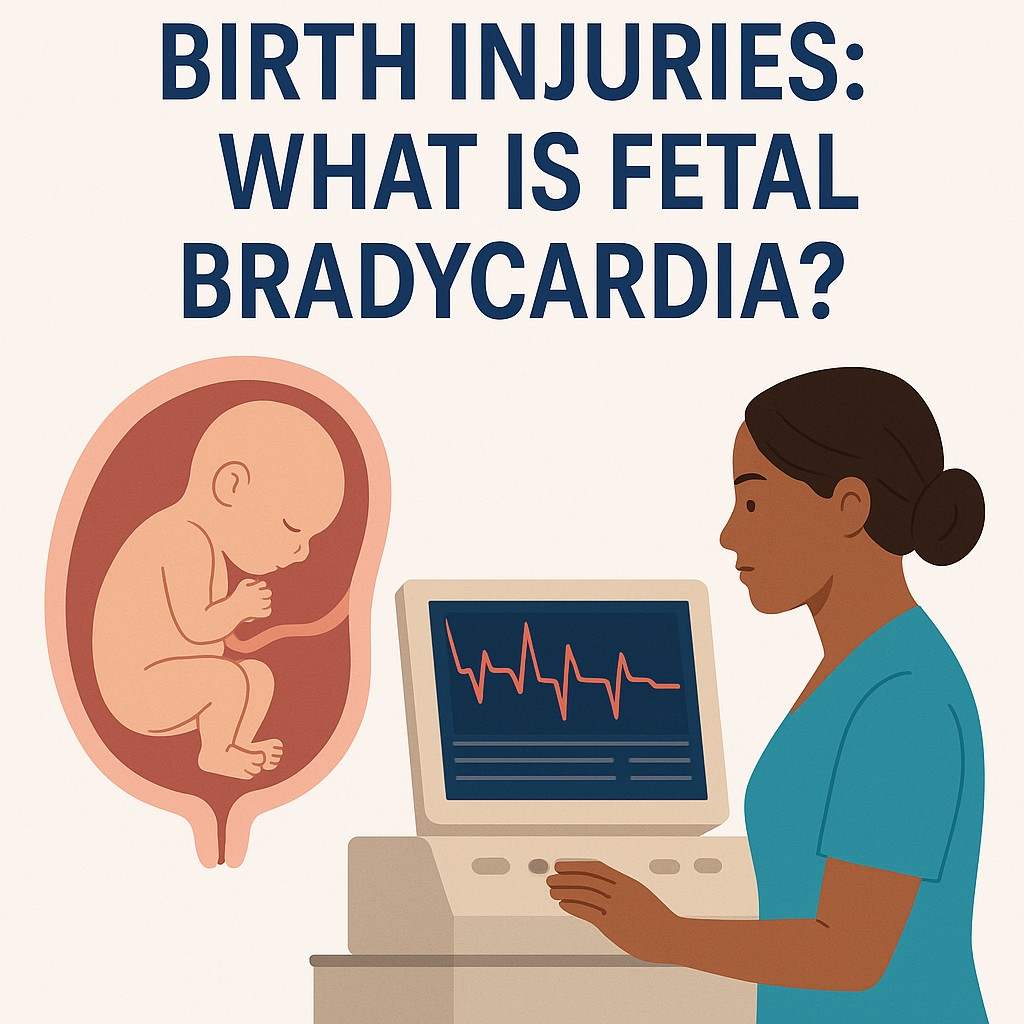
Parents rely on medical professionals to act promptly when something isn’t going right with their baby during labor. One condition that requires immediate attention is fetal bradycardia, a dangerously slow heart rate in the baby that can indicate oxygen deprivation or other complications. If not recognized and treated promptly, this serious condition can result in birth injuries with lifelong consequences. In this blog, we’ll explain what fetal bradycardia is, what causes it, how it’s detected, and whether it could form the basis of a medical malpractice claim in Maryland.
What Is Fetal Bradycardia?
Fetal bradycardia is a slower-than-normal heart rate in a baby before or during labor. A healthy fetal heart rate typically ranges from 110 to 160 beats per minute. However, medical providers should consider it a sign of distress when a baby’s heart rate consistently drops below 110 beats per minute for more than 10 minutes.
The condition often indicates limited oxygen flow to the baby, also referred to as fetal hypoxia. Without proper monitoring and prompt intervention, this condition can result in serious complications such as brain damage, developmental delays, or even stillbirth.
What Causes Fetal Bradycardia?
There are several potential fetal bradycardia causes, ranging from temporary positioning issues to serious medical emergencies. Understanding these causes can help families assess whether medical negligence may have played a role. Common causes may include:
- Umbilical cord problems—such as cord prolapse, compression, or a nuchal cord wrapped around the baby’s neck;
- Uterine rupture—a rare but life-threatening condition where the uterus tears during labor;
- Placental abruption—when the placenta detaches from the uterine wall prematurely, cutting off oxygen supply;
- Maternal hypotension—low maternal blood pressure can reduce blood flow to the fetus;
- Medications—some labor-inducing drugs, such as Pitocin, can overstimulate contractions and reduce oxygen to the baby;
- Congenital heart block or fetal arrhythmia—underlying fetal heart conditions may result in a persistently low heart rate; and
- Excessive or prolonged labor stress—prolonged contractions without adequate rest can cause fetal oxygen deprivation.
If any of these conditions exist and are not properly managed, medical staff may be held liable for any resulting birth injuries.
Fetal Bradycardia During Labor: What Should Medical Providers Do?
Labor and delivery teams are trained to use electronic fetal monitoring tools to assess fetal heart rate. These tools help detect changes in heart rate that may indicate fetal distress. If healthcare professionals observe bradycardia, immediate evaluation and intervention are required. Standard medical responses may include:
- Repositioning the mother to improve blood flow to the baby,
- Administering oxygen to the mother to increase fetal oxygen levels,
- Stopping medications like Pitocin that may be overstimulating the uterus, and
- Initiating an emergency cesarean section if the baby’s heart rate does not improve quickly.
When these responses are delayed or improperly executed, the baby may experience permanent harm. In such situations, families may have grounds to pursue a birth injury lawsuit.
Can Fetal Bradycardia Lead to a Medical Malpractice Claim in Maryland?
In Maryland, not every adverse birth outcome constitutes malpractice. However, if medical professionals neglect to recognize or respond to signs of fetal distress and that negligence results in a preventable injury, the family may have a legitimate legal claim.
Victims of medical malpractice in Maryland must file their lawsuit within the earlier of:
- Five years from the date of the injury (statute of repose), or
- Three years from the discovery date of the injury.
However, the timeline is extended in birth injury cases, where the statute of limitations usually does not begin until the child turns 18. This provision allows families time to evaluate developmental delays and long-term medical needs before pursuing legal action.
Due to the complexity of Maryland’s deadlines and legal standards, consulting a knowledgeable medical malpractice attorney is essential for any family contemplating a claim.
Why Choose Brockstedt Mandalas Federico?
Navigating the aftermath of a birth injury is both emotionally and financially overwhelming. Our legal team understands the deep pain associated with a preventable injury during childbirth. We are committed to holding negligent healthcare providers accountable and helping families secure the necessary resources for their child’s care.
At Brockstedt Mandalas Federico, our commitment to justice is reflected in the remarkable achievements of our legal team. Partner Philip Federico has pioneered groundbreaking litigation, securing verdicts and settlements surpassing one billion dollars. Our firm’s dedication to excellence is further demonstrated by the recognition of six attorneys in the 2025 edition of Super Lawyers, including Partner Tara Clary and Wray Fitch as first-time Maryland Super Lawyers and Partner Brent Ceryes and Matthew Legg as Rising Stars. Additionally, our attorneys have been honored in Lawdragon’s 500 Leading Plaintiff Consumer Lawyers and the Green 500 list for environmental law. These accolades emphasize our unwavering dedication to delivering outstanding results for our clients.
Taking the Next Step After a Birth Injury
Fetal bradycardia is a serious condition that can lead to devastating birth injuries if not promptly and properly addressed. If your child suffered harm due to delayed or inadequate care during labor, you may have legal options. If you believe your child’s injuries may have been preventable, reach out to us today. We can help you understand your rights and take the first steps toward securing justice for your child.
Frequently Asked Questions
What Are the Signs of Fetal Bradycardia?
The primary sign is a fetal heart rate consistently below 110 beats per minute. It may be detected via electronic fetal monitoring and accompanied by decreased fetal movement or other signs of distress.
Is Fetal Bradycardia Always Dangerous?
Not always. Brief dips in heart rate can occur during contractions and may not signal a problem. However, prolonged bradycardia requires immediate evaluation, as it may indicate oxygen deprivation.
Can You Sue for Fetal Bradycardia?
If fetal bradycardia was not properly monitored or treated and your baby suffered a birth injury as a result, you may have a valid medical malpractice claim. Speak to a qualified Maryland birth injury attorney for a case review.


